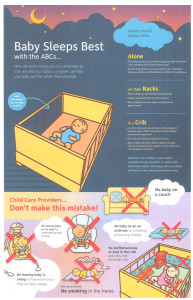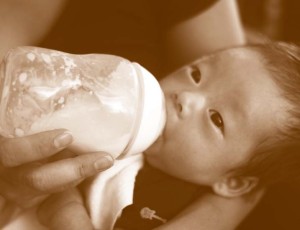Infant & Toddler Development
Newborn–1 Month
Congratulations! You now are discovering for yourself what it’s like to be a parent. Learning how to take care of a baby takes time and practice; it doesn’t always come naturally. The Parent Line Newborn–3 Month Keiki Guide will give you tips to help make your parenting easier and a more rewarding experience.

What it’s like to be a newborn
How I grow…
- I like to sleep a lot.
- I am hungry every few hours.
- My face may be wrinkled, puffy, or red.
- I have a large head.
- I grasp an object or your finger if it is placed in my hand.
- I need my head supported when I am lifted or carried.
How I talk…
- I may be fussy and cry frequently. This may just be my way of “letting off steam”.
- I may look away, make a fist, or curl my toes. These signs may be my way of telling you I need less excitement.
How I respond…
- I like to look at your face.
- I may calm down when someone picks me up.
- I like to listen to your voice.
- I startle and cry when I hear loud noises or when my crib is bumped.
- I am sensitive to light and will keep my eyes shut in a brightly lit room.
How I understand…
- I like to be held gently and close to you. I get a sense of security that way.
How I feel…
- I like to feel warm and safe.
- I don’t like lots of noise.
- I feel pain and distress and let you know about.
How you help me learn…
- Change my position occasionally.
- Hold me close and cuddle, hug, and rock me.
- Put a mobile 8-12 inches away from my face on either my far right or left side so I can see it.
- I especially like black and white or contrasting colors.
- Let me listen to wind chimes, musical toys, or soft music.
- Sing a lullaby to me. I like “Rock-a-bye baby.”
- Talk to me about what I’m looking at and what’s happening as you change my diaper and bathe me.
What it’s like to be 1 month
How I grow…
- I turn my head sideways when I’m on my stomach.
- I root around and try to suck, even when I’m not feeding.
- I may use only one eye at a time, keeping the other one closed. I may even cross my eyes sometimes.
How I talk…
- I am beginning to make some different sounds.
- I cry when I’m hungry, wet, tired-or when I want to be held.
How I respond…
- I make eye contact with you.
- I stare at things, but I don’t grab for them yet.
- I may smile when I see or hear you.
- I get scared by loud noises, bright lights, and rough handling.
How I understand…
- I prefer looking at patterns instead of solid colors.
- I need to be fed when I’m hungry.
How I feel…
- I feel comfortable when you hold me close.
- I show distress when I am in pain.
How you can help me learn…
- Smile and talk gently to me.
- Do not be afraid of spoiling me.
- Show me bright colors (red and yellow are favorites).
- Put a mirror or poster next to my diapering area.
- Move the mobile to the center of the crib in front of me.
- Lie down and put me on your chest. I like to feel you breathing and your heart beat helps me feel secure.
- Read to me for a few minutes every single day. Though I may not be able to clearly see the pictures or understand what you are saying, I will become familiar with your tone of voice and pattern of speech. Reading to me helps my brain develop.
Safety & Your Baby
Sleeping
Babies should not sleep on soft mattresses, pillows, waterbeds or other soft surfaces. Keep toys, quilts, and blankets out of the crib until your baby is older. We do not recommend sleeping with baby, but if your baby is in your bed, be careful. You could roll over them, especially when you’re tired. Unless your doctor suggests otherwise, place your baby on his back to sleep. When he is awake, he should spend time on his stomach. Click here for the safe sleep brochure.
Car Seats
Car seats are highly effective in preventing injury and death to children. Hawai‘i law requires approved car seats for children under the age of four. The back seat is the safe place to put your car seat. Children 12 months and younger or weighing less than 20 lbs. need to be in rear facing car seats.
Be gentle — never shake your keiki!
You may be surprised at the range and depth of feelings you have toward your baby—from anger and resentment to sheer delight and joy. Be gentle. Even when you’re just playing, shaking a baby can cause serious injury or even death. Shaking can hurt the head, neck or back of your baby. Shaking can cause brain or nerve damage, blindness or eye injury. Hitting, biting, and other rough treatment can break softly-formed bones and can hurt internal organs.
Most babies are fussy and cry for part of the day. Your baby is too
young to understand that you want him to stop crying when you are
rough with him.
Things you can do instead:
- Put your baby in a safe place and leave the room, take a shower or play some calm music.
- Stop, sit down and count to 10.
- Try a pacifier.
- Call a friend or The Parent Line.
- Take your baby for a stroller or car ride.
Please be gentle!!
Your Baby’s Health
Dressing your baby
If you are comfortable in a room, then probably your baby is too. When the temperature is about 80 degrees F, you need not worry about your baby being cold. A diaper and light shirt will be just fine, but cover your baby when you go into an air-conditioned room. To tell if your baby is warm enough, touch his tummy or back.
In Hawai‘i, babies’ hands and feet often are covered by mittens and booties. Parents use mittens because they worry that their baby will scratch himself. Careful trimming of your baby’s nails is preferable to using mittens. He needs to have his hands and feet free. He learns about his world by grasping, touching, and feeling.
Colic
Colic is both one of the most common and most puzzling problems of early infancy. About 20% of babies have “colic.” They often cry inconsolably for up to 3-4 hours at a time. They may stretch their legs out, pull their legs up, and arch their backs. These episodes frequently occur after feeding. Colic is likely to end by three to four months of age, but this is small comfort to the parent of an infant who is in obvious pain. If your baby cries hard all day long and nothing seems to help, see your doctor.
No one is sure what causes colic. Some researchers suggest that colic may be caused by your baby’s immature digestive or nervous systems. As your baby grows these systems mature. A few months may make all the difference. Some studies suggest that colic in breast-fed babies may be caused by certain foods in the mother’s diet. Check with your doctor before changing your own or your baby’s diet.
Things you can try that may help:
- Feed your baby in an upright position whether he is being breastfed or bottle-fed. Sit comfortably in a chair and allow him to “sit” in your lap to feed.
- Ten minute feeding periods followed by five minutes of burping may help.
- A warm bath also may help. When you first put your baby into the water, he may cry even louder until the warm water relaxes the rectal muscle and allows him to pass gas.
- Use the special “colic hold” position, or place your infant across your knees on his stomach.
- Lay your baby on his back. Gently push his knees toward his stomach. Repeat several times. Gently rub his stomach.
- Any gentle motion seems to help, even a car ride.
It’s not your fault if your baby has colic, but it’s not his fault either.
He eventually will grow out of it. Meanwhile, take care of yourself. Feeling helpless when your baby cries is so stressful. Take a break if possible.
Feeding Your Baby
Breast and/or bottle?
Breast-feeding is the healthiest way to feed your baby. Breast-feeding is much less expensive than formula and much more convenient. Many mothers start out with good intentions but need encouragement. It may be harder to breast-feed than to bottle-feed in the very beginning, but is much easier than bottle-feeding after a few weeks. Getting support and information during these early weeks is crucial in helping you stick with it.
Breast-feeding may require some schedule adjustments so that you can be with your baby to nurse or can pump breast milk if you are away for many hours. These adjustments are easier when you have the support and encouragement of friends and family.
Breast milk is nature’s most perfect food and protects your child against disease. Studies show that breast-fed babies may have less serious allergies and less illness. They are often leaner in childhood. Brain development is also enhanced by breast-feeding. If you can’t or choose not to breast-feed, there are many nutritious formulas available. Talk to your doctor when choosing which formula to use.
All babies spend a lot of time eating. Both formula-fed and breast-fed babies benefit from being held and being moved from arm to arm while nursing. One of the most important parts of feeding is the warmth and pleasure your baby feels while being held and fed.
Your baby depends on you, so take the time you need to rest. Eat healthy foods and keep plenty of water handy.
A balanced diet includes:
- 8 or more servings of bread, cereal, rice, noodles, and pasta or starchy vegetables
- 6–7 servings of fruits and vegetables
- 3 servings of milk, yogurt and cheese or other calcium rich foods
- 2–3 servings of meat, poultry, fish, beans, eggs, tofu and nuts
You may notice that certain foods you eat affect your infant. It is probably best to avoid these while breast-feeding, but check with your doctor. Your doctor may also recommend a vitamin and fluoride supplement while you are breast-feeding.
Any medications you take can affect your breast-feeding infant. Avoid all street drugs and check with your doctor before taking nonprescription medications or alcohol.
*“Feeding Your Baby” revisions by Patricia Britten, M.S. Extension Specialist in Foods and Nutrition Cooperative Extension Service University of Hawai‘i
Take Care of Yourself
If you need support or have any questions about your child’s behavior or development or need community services, call The Parent Line.
A Parent Asks
Q – I thought most childhood diseases had been eliminated. Is it really necessary for my baby to be immunized?
A – Yes. Most definitely your baby needs to be immunized. Childhood diseases do exist. Although they may not be as widespread as in the past, they are just as deadly. Many childhood diseases can be prevented through vaccination.
Immunizations help to trigger your child’s own protective mechanisms to keep him safe from certain diseases. By two years of age, the primary immunization series should be completed.
A serious reaction to a vaccination rarely occurs. There is a risk associated with every medical procedure, but all vaccines are thoroughly tested for their safety. For more information about immunizations, contact your doctor.





